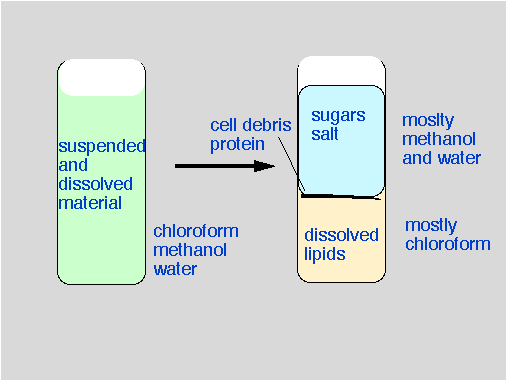

EXTRACTION OF LIPIDS FROM LIPOPHORIN
Since lipids
are hydrophobic, they are better soluble in organic solvents than
in water. Because the lipids are buried into protein particles
simple shaking of the aqueous protein solution with an immiscible
solvent will not lead to efficient extraction.  The method of choice is a one phase extraction, as pioneered by
Folch and modified by Bligh and Dyer
(1959). Water, methanol, and chloroform are mixed in the ratio
1:2:0.8. Under these conditions, all three solvents remain mixed,
and the lipoproteins are exposed to the solvent molecules. Subsequently,
water and chloroform is added to shift the ration to 2:2:1.8,
now the polar and nonpolar solvents are no longer miscible, and
we get two phases.
The method of choice is a one phase extraction, as pioneered by
Folch and modified by Bligh and Dyer
(1959). Water, methanol, and chloroform are mixed in the ratio
1:2:0.8. Under these conditions, all three solvents remain mixed,
and the lipoproteins are exposed to the solvent molecules. Subsequently,
water and chloroform is added to shift the ration to 2:2:1.8,
now the polar and nonpolar solvents are no longer miscible, and
we get two phases.
Note: Chloroform is heavier than water. The speed
and ease of this method make it suitable for multiple extractions,
e.g. of plasma samples, provided that a small amount of of aqueous
contamination can be tolerated.
Use only glass pipettes throughout this
experiment.
Always make a flow chart of the procedure prior
to carrying out the experiment.

1. Retrieve the lipophorin from the freeze-dryer, weigh out the lyophilized powder and put in a small 7 ml glass vial. Close with a lid containing teflon lining. 2. To your freeze-dried lipophorin, add 0.8 ml water. Shake vigorously to suspend the lipoprotein.
3. Add 10 µl of internal lipid standard (solution contains 1 mg/ml of all standards) per mg protein (as weighted out).
4. Add chloroform and methanol, mixing in the vortex and homogenizing using a pasteur pipette after each addition so that the final proportions are now
| chloroform | methanol | water |
|
|
|
|
5. Allow to stand for 10 min at room temp.
6. Add 1 ml chloroform and 1 ml water, mixing and homogenizing as above after each addition. The final proportions are now
| chloroform | methanol | water |
|
|
|
|
7. Centrifuge in the Hermle centrifuge (in B 8220) for 5 min at 4000 rpm to form two layers. (Use large rubber adapters so that the vial can be removed without disturbing the layers). The lower, chloroform layer contains lipids. The upper layer contains water, methanol, and water soluble salts.
8. Transfer the lower chloroform containing layer (using a pasteur pipette) into clean glass vials. Make sure to prevent contamination from the upper layer or the interphase. If the transferred chloroform phase contains water (it may look cloudy), dry the solution by adding a spatula full of anhydrous sodium sulfate. Decant into a new vial, and evaporate the solvent (in the fume hood) in a stream of nitrogen.
9. You should see some yellow semi-liquid phase at the bottom of the vial. This is your lipid extract. Use the Teflon coated lids. Store at -20 °C.
[ BISC
429 home] [ Enzyme isolation ]
[ Lipoprotein isolation ] [ Lipid analysis ] [ DNA
isolation ] [ feedback ]